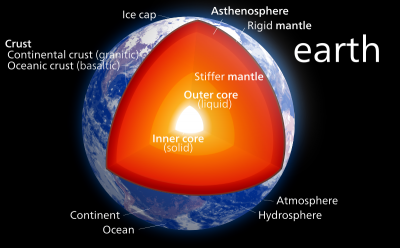
PLANET EARTH
Earth was created some 4.5 billion years ago from a mass of iron-rich, rocky debris orbiting the Sun. The rocks smashed into the young planet as meteorites, and were welded together by heat generated from the energy of impact. The bombardment eventually generated so much heat that the whole planet melted. The heavy iron then sank towards the centre to become Earth’s core, while the lighter rocks formed the mantle and crust.
EARTH’S STRUCTURE
The planet is layered like a peach. Earth’s rocky crust forms its thin skin, while the hot, mobile rock of the mantle is like the peach’s juicy flesh. At the heart of the planet lies its metallic core, like the hard stone at the centre of a peach.
ON THE SURFACE
Movement in the thick, hot mantle has made the thin, cool crust crack into several huge plates. The boundaries of these plates are marked by earthquake zones dotted with volcanoes, and mountain ridges pushed up where moving plates collide.
- INNER CORE
The inner core is a heavy ball of solid iron and nickel. It is heated by nuclear reactions within Earth to 4,700°C (8,500°F), but the intense pressure at the core prevents it from melting.
- OUTER CORE
The solid inner core is surrounded by a fluid mass of molten iron, nickel, and sulfur. Swirling currents in the molten metal of the outer core generate Earth’s magnetic field.
- LOWER MANTLE
The rocky mantle is 2,900 km (1,800 miles) deep, and is heated to 3,500°C (6,300°F) at its base. Intense pressure stops it melting, but rising heat keeps the hot rock moving slowly.
- UPPER MANTLE
The upper mantle is heated to almost 1,000°C (1,800°F). Where movement in the mantle cracks the cool, brittle crust, reduced pressure makes the hot mantle rock melt and erupt from volcanoes.
- OCEANIC CRUST
The crust between the continents is less than 11 km (7 miles) thick. It is, made of heavy rock that erupts from the hot mantle at mid-ocean ridges to form the bedrock of the ocean floors.
- CONTINENTAL CRUST
The lightest of Earth’s rocks form vast slabs that “float” on the heavy mantle like huge rocky rafts. Up to 70 km (45 miles) thick, they rise above sea level to form the continents we live on.
- LAND SURFACE
Exposed to frost, wind, rain, and hot sunlight, the rocks at the land surface are broken down by weathering and erosion. This releases minerals that are vital to plants and other life.
- OCEANS
The low-lying basins between the continents are filled with water, to an average depth of 3.7 km (2.3 miles). Most of the water erupted from volcanoes as water vapour early in Earth’s history.
- WEATHER SYSTEMS
The heat of the Sun makes water evaporate from the oceans and rise into the lower atmosphere. The water forms swirling masses of cloud that spill rain onto the continents, allowing life to exist on land.
- ATMOSPHERE
Earth’s mass gives it enough gravity to retain an atmosphere of nitrogen, oxygen, and other gases including carbon dioxide. This keeps Earth warm at night, and shields it from dangerous radiation.
THE MOON
Soon after Earth formed, it was hit by a planet-sized asteroid that completely disintegrated. Most of its heavy metallic core melted into Earth, but the lighter rocky fragments drifted into orbit and eventually fused to form the Moon.
Picture Credit : Google



